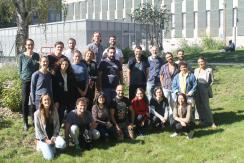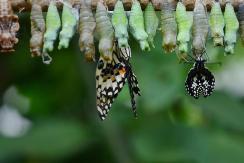COEVOL Multi-Scale Coevolution
Living systems are highly integrated, with a multitude of levels of organization, from molecular and intra-cellular scales to ecosystems. Complex organisms are themselves consortia of macro- and micro-organisms, which work together with their host to build the individual. Yet, each of these organisms can function and evolve in the short term according to its own logic, possibly in conflict with other higher or lower levels, or with other time scales. The once common idea among evolutionists that natural selection results in organisms perfectly adapted to their environment is now severely undermined. Not only because, as the Red Queen explains to Alice, one has to run relentlessly to keep its place in a changing environment, or because past evolutionary history and chance constrain the possibilities of present adaptation, but also because different levels of selection have interests that are generally difficult to reconcile.
Multi-scale coevolution resets classical questions in evolutionary biology
One example, of particular interest is the question of the source of heritable variations. The phenotype of organisms in a population is influenced not only by variations in their nuclear and mitochondrial genomes, the dynamics of which is the object of population genetics, but also more and more patently by the consortium of microbes and genetic elements that constitute its microbiome and virome. The hologenome designates this complex assembly of genetic materials, which obey different rules of transmission and different evolutionary strategies. The ability of symbionts to manipulate host phenotypes or to interfere with each other influences the evolutionary dynamics of all players in ways that are yet poorly understood. In addition, new questions arise, such as the importance of co-adaptation in these systems and their consequences in maintaining cohesive biological systems.
- Symbiosis: a response to and a source of divergent selection
Using a variety of approaches combining experimental evolution, genomic, functional, phenotypic and behavioral data, we aim to test whether symbiosis facilitates diversification and to characterize the underlying microevolutionary processes.
- Ecological networks of horizontal gene transfer
We develop original methods to detect gene transfer and we investigate the factors that influence the routes of gene transfers among microbes but also among insects.
- The interplay between symbiosis, infection and immunity and its evolutionary consequences
We try to understand the intimate interaction of hosts with pathogens, symbionts and transposable elements and how it affects the extended phenotype of the host.
- Transgenerational inheritance and environment changes
We try to decipher the molecular mechanisms that underlie rapid adaptation to environment and to test for transgenerational inheritance of fitness traits.
- Intragenomic conflicts and demography
We are developing models to test whether changes in the demography of the host affect the dynamics of transposable elements.
- The determinism of phenotypic convergence
We study the genomic basis of convergent phenotypic evolution in particular in the case of animals and plants adaptation to increasing temperature and decreasing water.
- Reconciling the tree of life
We develop phylogenetic methods for “reconciling” gene/species or host/symbiont histories and use these methods to explore the bulk of extinct or undescribed species and the history of association of symbiotic microbes with their hosts.
Integrating methods
The methods we use to tackle the questions raised by multi-scale co-evolution extend from theory, modelling and simulation to big data analysis, lab (notably on insects), and to a lesser extent, field activities.
Implication of research, responsibility of researchers and citizen sciences
From our research (some of which have immediate consequences in health, agriculture and ecology) and our concerns about the responsibility of scientists in society, we are committed to promote an “implicative” research. The implicative position means that we try to work on the link between science and society, not only through a one-way communication, applying or explaining our science, but also favoring early discussions on research projects, that may influence our research directions.
Publications
Display of 331 to 360 publications on 706 in total
Probabilistic Graphical Model Representation in Phylogenetics
Systematic Biology . 63 ( 5 ) : 753-771
Journal article
see the publicationHost Control of Insect Endogenous Retroviruses: Small RNA Silencing and Immune Response
Viruses . 6 : 4447-4464
DOI: 10.3390/v6114447
Journal article
see the publicationPhylogeny of the class Actinobacteria revisited in the light of complete genomes. The orders 'Frankiales' and Micrococcales should be split into coherent entities: proposal of Frankiales ord. nov., Geodermatophilales ord. nov., Acidothermales ord. nov. an
International Journal of Systematic and Evolutionary Microbiology . 64 ( Pt 11 ) : 3821-32
Journal article
see the publicationCounting and sampling SCJ small parsimony solutions
Theoretical Computer Science . 552 : 83-98
Journal article
see the publicationA Genome-Wide Survey of Genetic Instability by Transposition in Drosophila Hybrids
PLoS ONE . 9 : 87 - 87
Journal article
see the publicationCould interallelic interactions be a key to the epigenetic aspects of fitness-trait inbreeding depression?
Heredity . 112 : 219-20
DOI: 10.1038/hdy.2013.80
Journal article
see the publicationFungal evolutionary genomics provides insight into the mechanisms of adaptive divergence in eukaryotes
Molecular Ecology . 23 ( 4 ) : 753-773
DOI: 10.1111/mec.12631
Journal article
see the publicationMicrobial impacts on insect evolutionary diversification: from patterns to mechanisms
Current Opinion in Insect Science . 4 : 29--34
Journal article
see the publicationEpidemiology of asexuality induced by the endosymbiotic Wolbachia across phytophagous wasp species: host plant specialization matters.
Molecular Ecology . 23 ( 9 ) : 2362-2375
DOI: 10.1111/mec.12737
Journal article
see the publicationSigns of Neutralization in a Redundant Gene Involved in Homologous Recombination in Wolbachia Endosymbionts
Genome Biology and Evolution . 10 ( 6 ) : 2654-2664
DOI: 10.1093/gbe/evu207
Journal article
see the publicationManipulation of arthropod sex determination by endosymbionts: diversity and molecular mechanisms
Sexual Development . : 59-73
Journal article
see the publicationEvidence for GC-biased gene conversion as a driver of between-lineage differences in avian base composition
Genome Biology . 15 : 549
Journal article
see the publicationStatistical binning enables an accurate coalescent-based estimation of the avian tree
Science . 346 ( 6215 ) : 1250463
Journal article
see the publicationStrepsiptera, Phylogenomics and the Long Branch Attraction Problem
PLoS ONE . 9 : e107709
Journal article
see the publicationWhole-genome analyses resolve early branches in the tree of life of modern birds.
Science . 346 ( 6215 ) : 1320-31
Journal article
see the publicationMassive gene swamping among cheese-making Penicillium fungi
Microbial Cell .
Journal article
see the publicationHigh Variability of Mitochondrial Gene Order among Fungi
Genome Biology and Evolution . 6 ( 2 ) : 451-465
DOI: 10.1093/gbe/evu028
Journal article
see the publicationReductive genome evolution at both ends of bacterial population size spectrum
Nature Reviews Microbiology . 12 ( 12 ) : 841-850
DOI: 10.1038/nrmicro3331
Journal article
see the publicationRibosomal proteins: Toward a next generation standard for prokaryotic systematics?
Molecular Phylogenetics and Evolution . 75 : 103 - 117
Journal article
see the publicationSingle acquisition of protelomerase gave rise to speciation of a large and diverse clade within the Agrobacterium/Rhizobium supercluster characterized by the presence of a linear chromid
Molecular Phylogenetics and Evolution . 73 : 202-207
Journal article
see the publicationA Bayesian Method for Analyzing Lateral Gene Transfer
Systematic Biology . 63 ( 3 ) : 409 - 420
Journal article
see the publicationThe Drosophila Su(var)3–7 Gene Is Required for Oogenesis and Female Fertility, Genetically Interacts with piwi and aubergine, but Impacts Only Weakly Transposon Silencing
PLoS ONE . 9 ( 5 ) : e96802
Journal article
see the publicationGenomic regions harboring insecticide resistance-associated Cyp genes are enriched by transposable element fragments carrying putative transcription factor binding sites in two sibling Drosophila species
Gene . 537 ( 1 ) : 93-99
Journal article
see the publicationThe oxidative environment: a mediator of interspecies communication that drives symbiosis evolution
Proceedings of the Royal Society B: Biological Sciences . 281 ( 1785 ) : 20133112 - 20133112
Journal article
see the publicationA model symbiosis reveals a role for sheathed-flagellum rotation in the release of immunogenic lipopolysaccharide
eLife . 3
DOI: 10.7554/eLife.01579
Journal article
see the publicationThe dual nature of haemocyanin in the establishment and persistence of the squid - vibrio symbiosis
Proceedings of the Royal Society B: Biological Sciences . 281 ( 1785 ) : 20140504
Journal article
see the publicationExposure to hycanthone alters chromatin structure around specific gene functions and specific repeats in Schistosoma mansoni.
Frontiers in Genetics . 5 : 207
Journal article
see the publicationSpecific Activation of an I-Like Element in Drosophila Interspecific Hybrids
Genome Biology and Evolution . 6 : 1806 - 1817
DOI: 10.1093/gbe/evu141
Journal article
see the publicationThe Genome of Cardinium cBtQ1 Provides Insights into Genome Reduction, Symbiont Motility, and Its Settlement in Bemisia tabaci
Genome Biology and Evolution . 6 ( 4 ) : 1013-1030
Journal article
see the publicationThe sublethal effects of deltamethrin on Trichogramma behaviors during the exploitation of host patches
Science of the Total Environment . 447 : 274-279
Journal article
see the publication

